When was the first commercial coast to coast flight?
US History of Tourism, first coast to coast flight: Transcontinental Air Transport (TAT) was an airline founded in 1928 by Clement Melville Keys that merged in 1930 with Western Air Express to form what became TWA. The Transcontinental Air Transport airline was like “The Lindbergh Line” and the idea began in the months after the 1927 transatlantic flight of Charles Lindbergh.
USA History of Tourism – The Lindbergh Line – First Coast to Coast Flight – Transcontinental Air Transport – TAT – Ford Tri-Motor
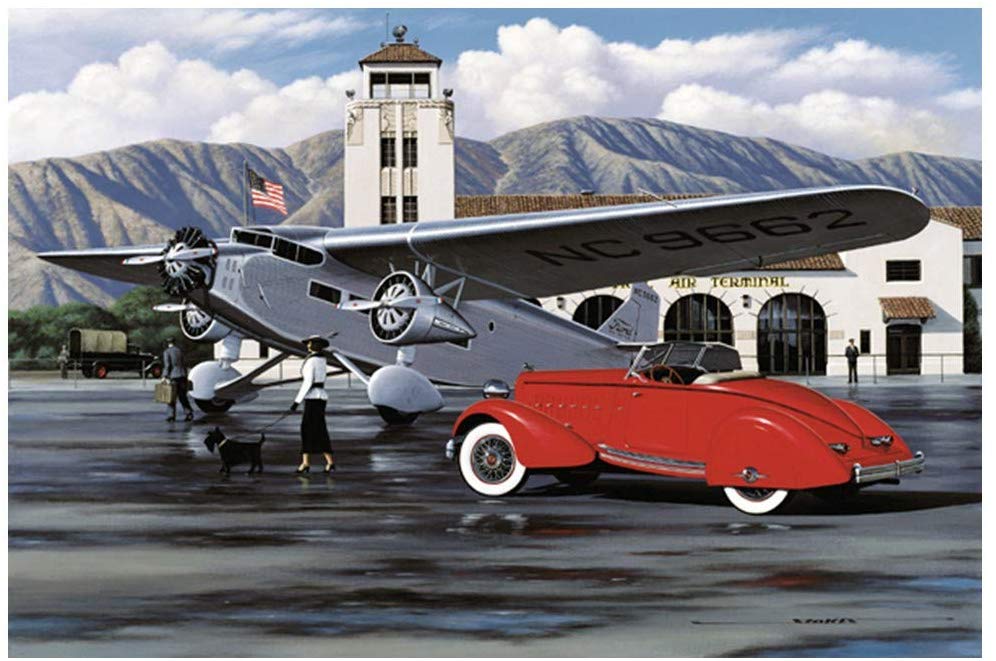
Who were the sponsors of the first commercial coast-to-coast flight in the USA?
The main sponsors of this commercial airline were:
- Charles Lindbergh,
- Harold Bixby,
- Henry Breckinridge,
- Harry Knight
- Commander William Robertson
They set out to unite the coasts of the Atlantic and the Pacific, between the cities of New York and Los Angeles
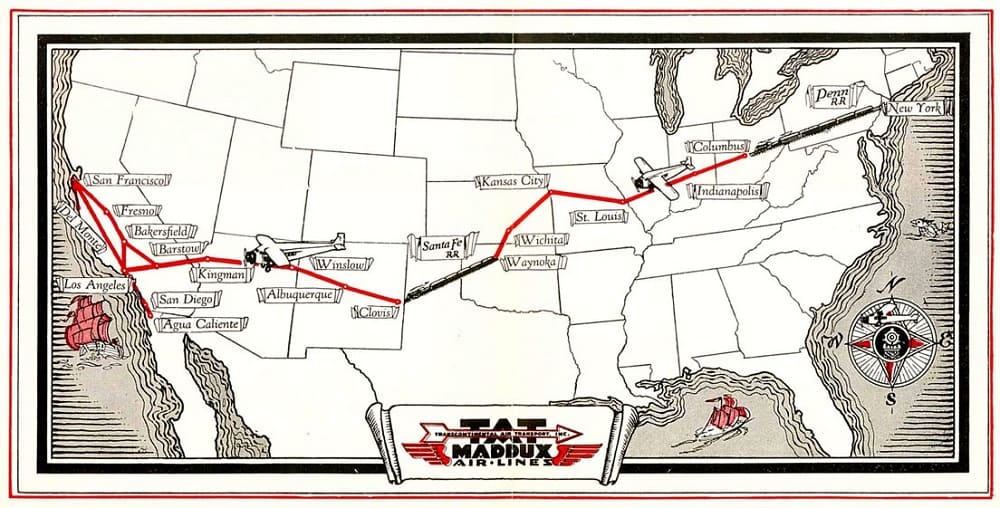
Vintage Posters Ads & Prints on Amazon
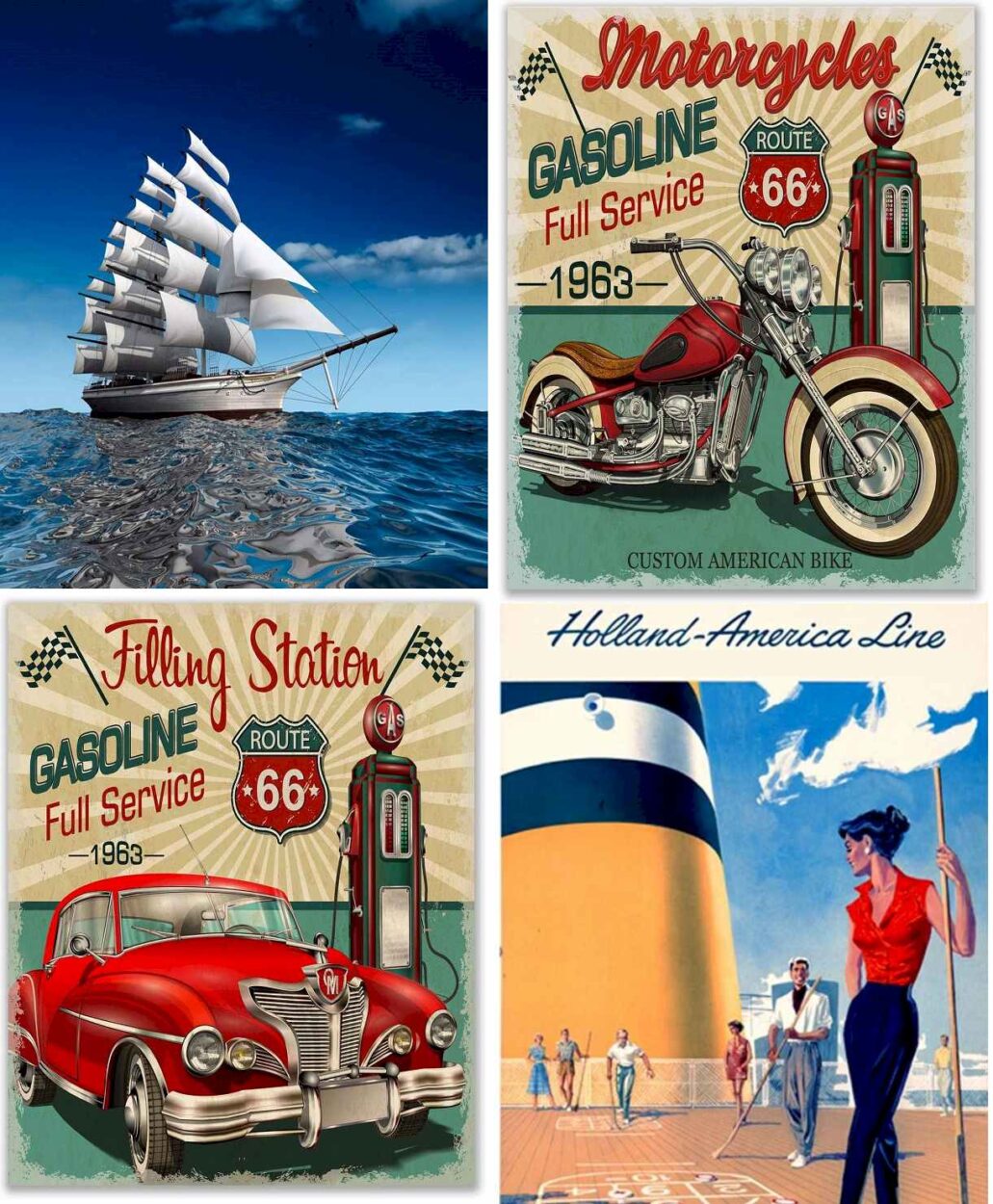
TAT investors were: The Curtiss companies, the Wright Aeronautical Corporation, the Atchison Railroad, Topeka and Santa Fe plus five investment banks. In the spring of 1928, the group formed Transcontinental Air Transport, Inc., with Clement Melville Keys (Curtiss) as chairman and a board of directors composed of representatives of major investors.
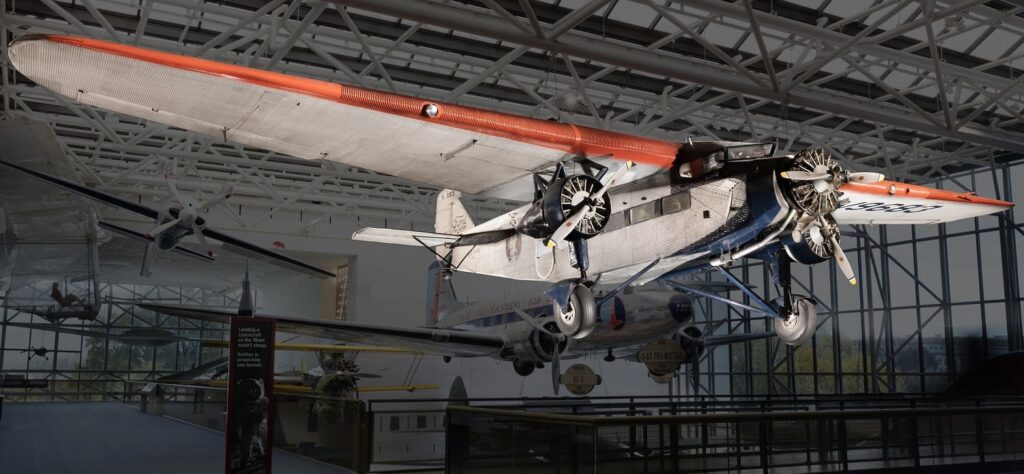
Charles Lindbergh Chairman of TAT Technical Committee
Charles Lindbergh became Chairman of the TAT Technical Committee. The Lindbergh Technical team designed the air route to follow. They chose 10 cities spaced between the coasts: Columbus, Ohio; Indianapolis, Ind .; St. Louis, Mo .; Kansas City, Kan .; Wichita, Kan .; Waynoka, Okla .; Clovis, NM; Albuquerque, NM; Winslow, Ariz .; and Glendale, California.
Transcontinental Air Transport bought or rented sites for airports. Pilots and mechanics were also hired, coordinated airline and rail schedules. They also directed the construction of runways, airport terminals and weather stations.
TAT tested the schedules of the stops between June 20 and July 6, 1929. Several pracytical trips and training with teams and personnel were made. Before the first client traveled, almost 50,000 test miles were recorded. Also transported 261 passengers through the different sections of the TAT route to make sure everything was ready.
How Were the Ford Trimotor 5-AT?
The Ford Tri-Motor was popularly dubbed the “Tin Goose”. Its corrugated metal fuselage looked like a tin washboard, and his body seemed to crawl on the ground like the belly of a goose. The plane chosen by Lindbergh was the Ford TriMotor. According to Lindbergh, the Ford had more power and better maintenance than any other airplane.
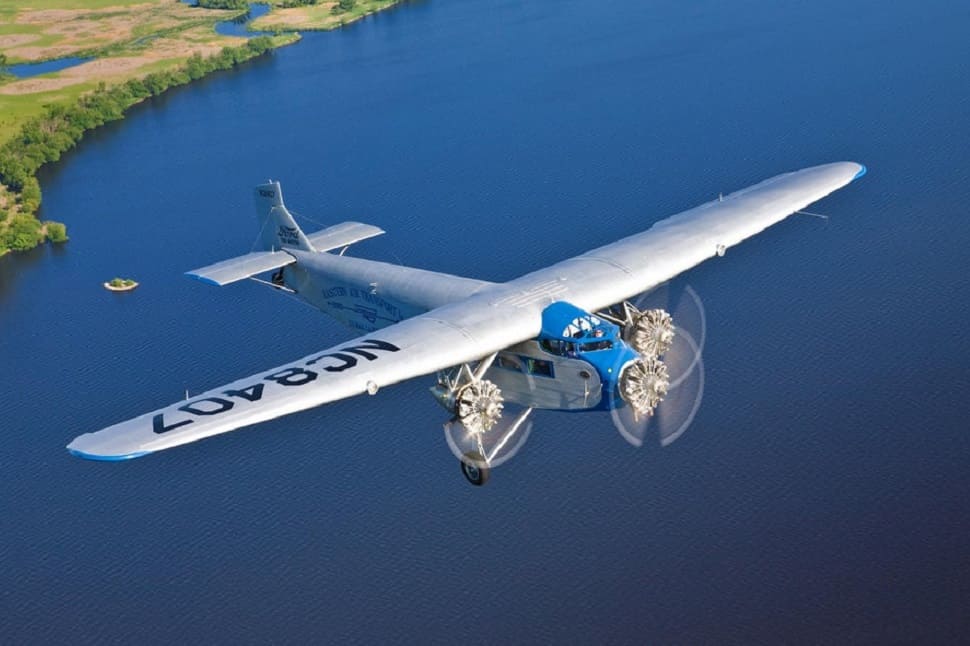
Having three engines made flying on that plane safer than on other planes of that time. If one or maybe two engines stop running in flight, the TriMotor could land safely with only one of the two engines. The plane’s cabin could accommodate a maximum of 10 passengers. The plane had been built to transport more people but Transcontinental Air Transport dismantled six seats to leave the place for a kitchen.
A very narrow corridor ran through the center of the passenger cabin. Next to each seat was a window covered with velvet curtains. Each passenger had their own reading lamp and also an electric lighter with an ashtray. The seats were adjustable to three positions and resembled more common splinters than the current seats of an airplane. The Ford TriMotor had a top speed of 110 miles per hour.
First Coast to Coast Flight: Inauguration Day in NYC
On July 7, 1929, transcontinental travel began. He initially offered a 48-hour coast-to-coast travel (night trains and day planes on several flights). The first Passengers had to board, first, a night train to take them to the airport in Columbus, Ohio (today is John Glenn International Airport), 850 miles away.
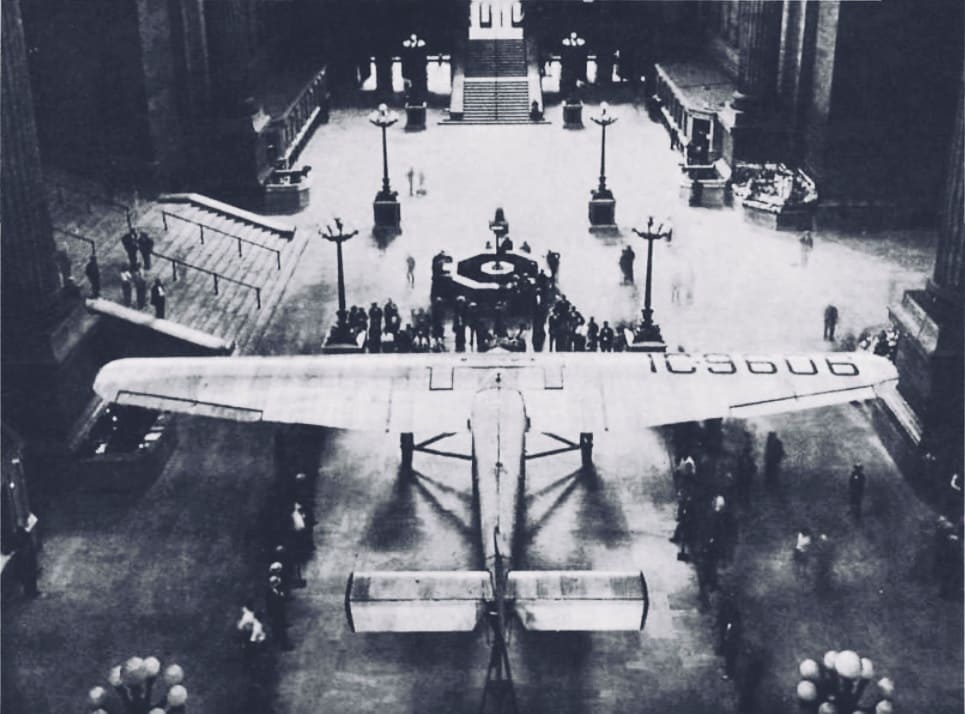
At the NYC Pennsylvania station, a Ford Tri-Motor called City of New York was in the hall. He was taken for the occasion and was Christening by Amelia Earhart. After the speeches, passengers boarded The Airway Limited on Platform 15, and the train departed to Columbus at 6:05 pm
Vintage Posters Ads & Prints on Amazon
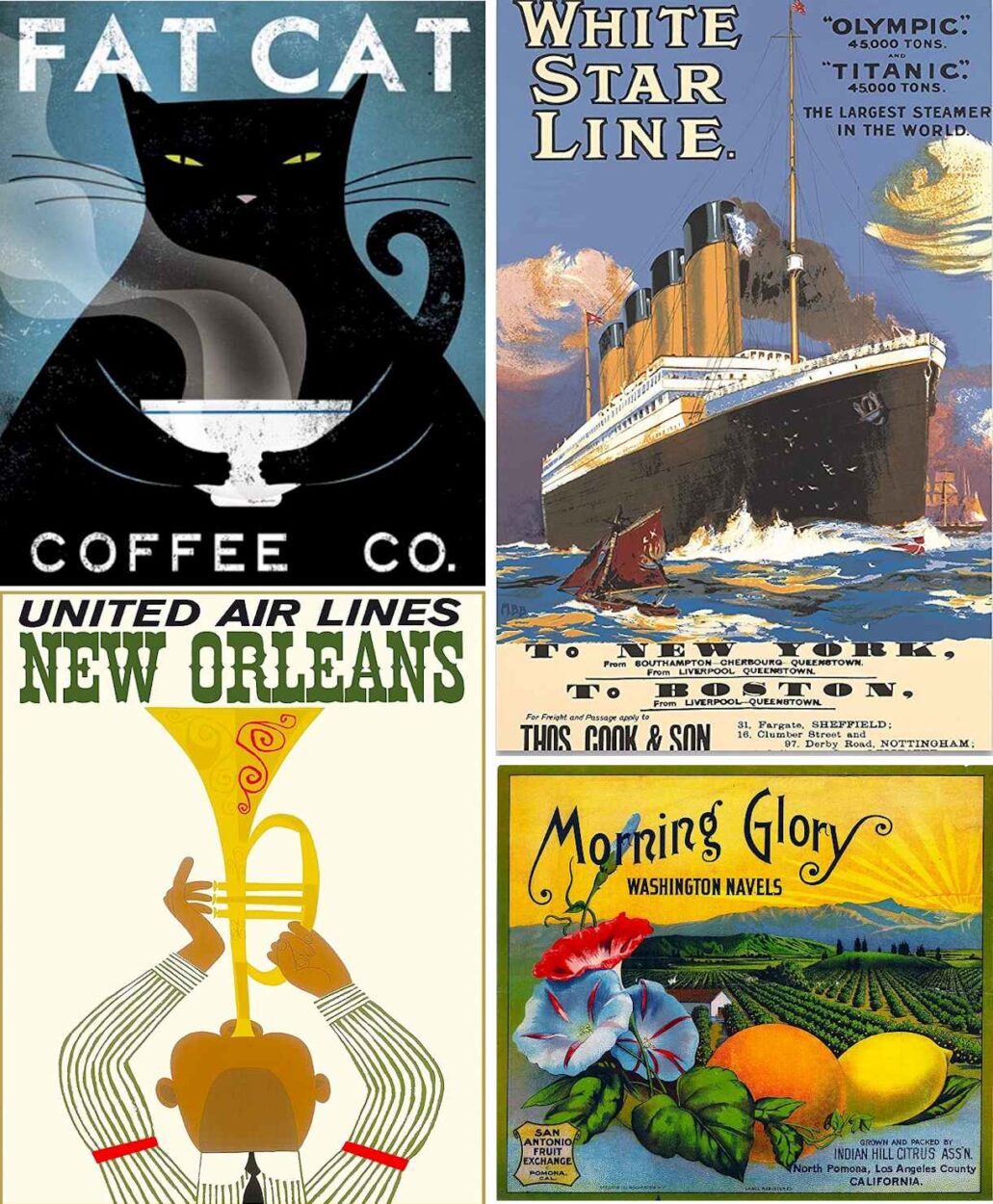
First Day: New York to Waynoka
Because The city’s Union Station was located in the city center, TAT built its own train station and terminal at the Columbus airport. Thus, the transfer from train to plane was faster and more comfortable for passengers. It was a cloudy day with light rain that fell in Columbus on July 8, 1929. Passengers who arrived at the new Columbus Penn train station walked down a gangway to the Ford Tri-Motors aircraft.
The plan was for two Tri-Motors to take off at the same time and move together across the continent. The Ford Tri-Motor chosen were the so-called City of Columbus and the City of Wichita.
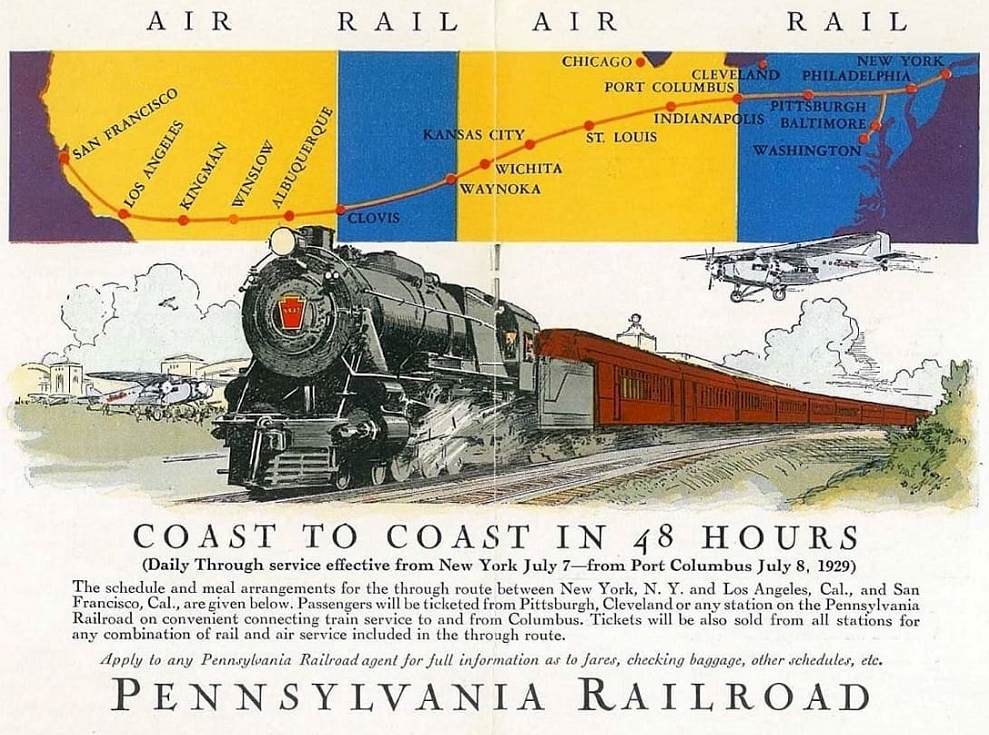
Who were the passengers on the first coast-to-coast flight in the USA?
The passengers on the City of Columbus Plane (2)
- Colonel Edgar S. Correll (President, Stutz Motor Company, IN)
- Paul Henderson. Jr. (Colonel Henderson’s son)
- Stay Brainerd (Associated Newspapers. NYC)
- S.W. Higgins (Dennison Manufacturing Company, MA)
- U. Grant Border (U.S. Border & Sons. NYC)
- J.W. Brennan, (Central Traffic Manager. TAT)
- Daniel M. Shafer (Chief of Passenger Transportation. Pennsylvania Railroad)
- Albert A Garthwaite. (Vice President. Lee Tire Company. PA)
The passengers on the City of Wichita Plane :
- Charles Tice (Fox Movietone News and Equipment)
- Carl Larsen (Fox Movietone News and Equipment)
- William Chaplin (Associated Press. NYC)
- Miss M.A. Salomon (Chamber of Commerce. Brooklyn. NY)
- Mn. John T. Litch (Boston. MA)
- E.E. Greiner (Springfield. OH) William James Bryant (Nation’s Business. D.C.)
- Mn. George P. Putnam (NYC) Mn. F.C. Kenney (Indianapolis. IN)
Carl Larsen and Charles, members of Fox Movietone, filmed the historic TAT inaugural trip across the United States. The film still exists and it’s very interesting to view (here) this documented trip across the continent.
After the two Ford Tri-Motor departed, Mr. T.B. Clement, the General Traffic Manager of Transcontinental Air Transport , hosted a breakfast in the TAT hangar. Important guests that attended the start of the inaugural flights and the celebration breakfast included
- Henry Ford. ( Chairman of Ford Motor Company)
- Eckel Ford (Henry Ford’s son);
- William B. Mayo (Chief Engineer of Ford Motor Company);
- Harvey Firestone (Firestone Tire Company).
Columbus Airport
Early in the morning , at the Columbus Airport (3), the passengers board a Ford Trimotor plane and fly to Waynoka – Oklahoma. The plane had to stop 4 times to refuel before arriving in Oklahoma. There they boarded another night train on the Santa Fe Railroad for a trip to Clovis, New Mexico. On the train they spent the night and arrived at the next airport.
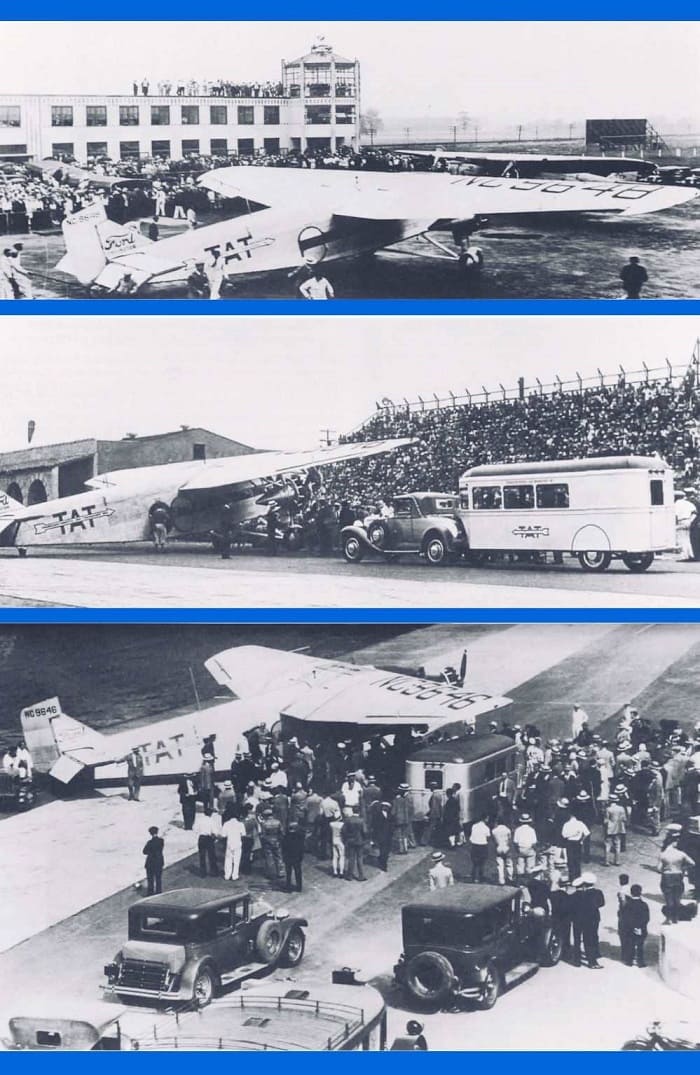
Around noon, the TAT flight stops in St. Louis, where pilots who had flown from Columbus were replaced by a new flight crew. TAT limited the flight time of its pilots to no more than five hours in the air in a single day. A TAT pilot earned more than $ 12,000 a year, more than double the salaries that most pilots earned at that time.
St. Louis to Kansas City: Lunch on Board
In the stage of St. Louis to Kansas City the passengers were served lunch. Ford trimotor stabilized, the service on board served some aluminum trays with napkin and tablecloth. The food was chicken, cheese and egg salad sandwiches, a pickle and salt. A piece of cake, an apple and a banana were also served. To accompany the meals the option was milk or coffee.
In Kansas City there was another technical stop, where any nervous passenger had the option of making a train connection. From Kansas City, the air route followed the Santa Fe rail route to the next stop in Wichita. Leaving Wichita, the trip to Waynoka was only 117 flight miles.
Samsonite Luggage Amazon
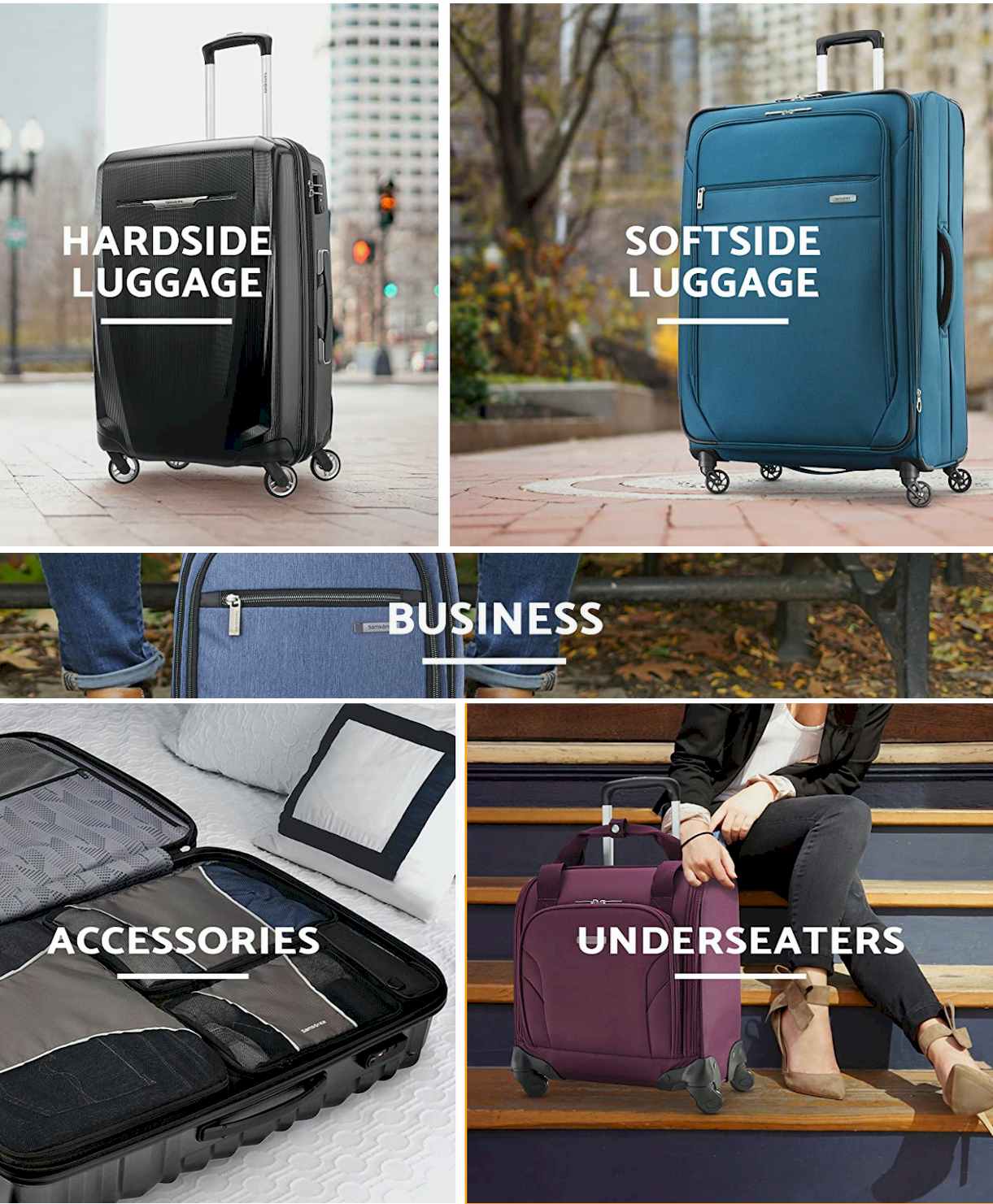
Landing in Waynoka
At Landing in Waynoka, TAT passengers are driven by car to the Atchison, Topeka and Santa Fe train station. There at dinner will be the Harvey House restaurant. The food was five stars;
- Blue knitted oysters
- Duck Salmi,
- Prairie Chicken with Redcurrant Jam
- Pickled lamb tongue.
At 8 pm, TAT service personnel accompanied passengers to a special railroad car (The Missionary) bound for Clovis. The train left Waynoka at 11 p.m. through western Oklahoma and northern Texas. He stopped in the cities of Woodward, Shattuck, Canadian, Miami and Amarillo. In Clovis, passengers had breakfast in other Harvey House, when they arrived at the City
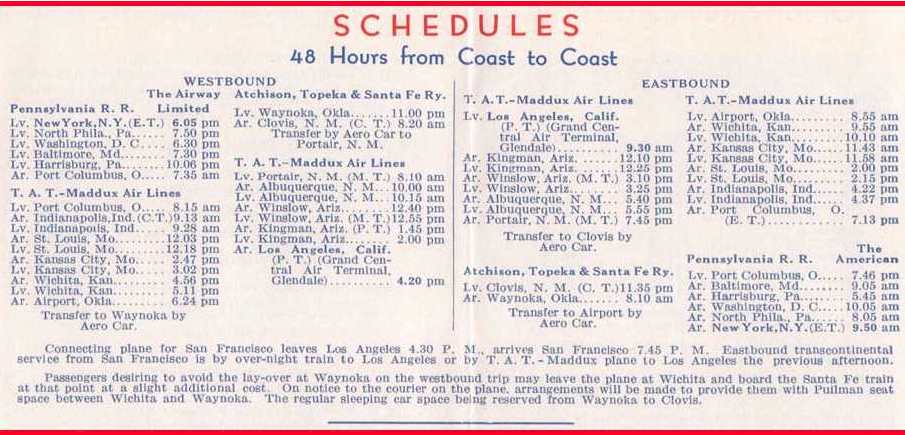
Second Day: Clovis to Los Angeles
First Coast to Coast Flight: From the Clovis train station, a car drove passengers to the Clovis terminal “Portair” five miles west of the city. The departure of the plane was scheduled for 8:10 AM. The plane took off and reached the height of 8,000 feet. Passengers expect a trip with three stopovers to refuel before reaching their final destination. The name of Ford Tri-Motor is “City of Wichita,”
Albuquerque was the first stop on the second day of flight. After the stopover, a light lunch was served and the service was withdrawn before arriving at the Continental Division. The most dangerous part of the trip, the flight from Albuquerque to Kingman through Winslow, was also the most picturesque.

In the late afternoon, the TAT Ford Tri-Motor approaches through the Cajon Pass between the San Bernardino and San Gabriel Mountains in California. Approaching Glendale Airport, their final destination, the plane slid over Pasadena, north of Los Angeles. Also about Hollywood and movie studios.
Sources First Coast to Coast Flight
- The Smithsonian Air & Space
- Flying In lingbergh Line – Robert F kirk
- The Building of an Airport : Port Columbus Robert F kirk
- Journal American Aviation Historical Society
- The Smithsonian Ford Plane
- Liberty aviation museum.org
- EAA Aviation Center – 3000 Poberezny Road – Oshkosh, WI 54902
- Palm Springs Air Museum
- Air Museum Guide
![Ford Tri-Motor - Flying the Lindbergh Line: Then & Now: (Transcontinental Air Transport'S Historic Aviation Vision) de [Kirk, Robert F.] Flying the Lindbergh Line: Then & Now: (Transcontinental Air Transport'S Historic Aviation Vision) de [Kirk, Robert F.]](https://images-na.ssl-images-amazon.com/images/I/51XTKvrD26L.jpg)
Coast to Coast Travel: Inauguration Day in Los Angeles
The same day at Grand Central Air Terminal near Los Angeles, two Ford Tri-Motor 1929 were christened. The TAT Tri-Motors were the Ciry of Los Angeles and the City of Philadelphia. Mary Pidcford christened the City of Los Angeles, and Gloria Swanson christened the Ciry of Philadelphia.
A huge crowd of approximately 30,000 turned out for the christening and viewed the historic beginning of transcontinental service to the east.
Charles Lindbergh piloted the City of Los Angeles on its inaugural travel to the east. (2)
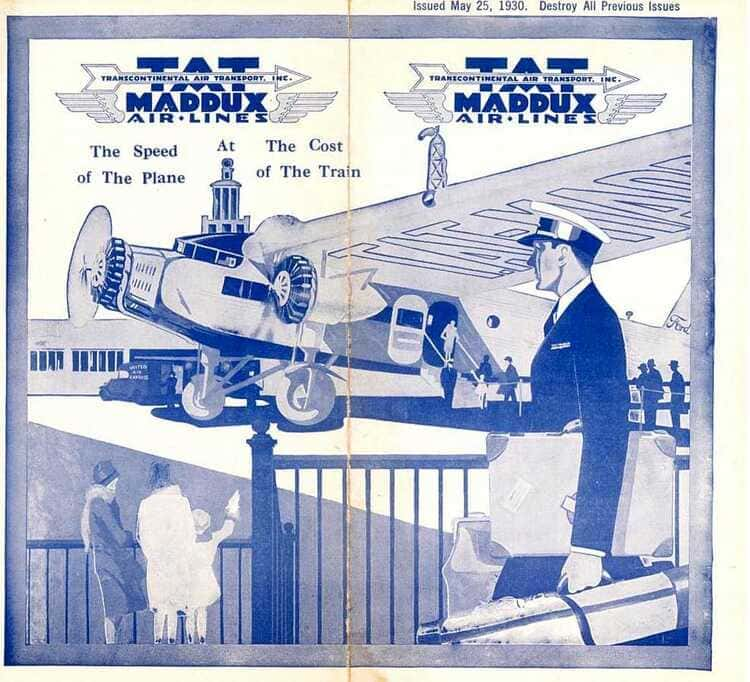
TAT – MADDUX Airline Brochure – May 25, 1930 “Western Division” (ex-Maddux Air Lines) Image from the collection of Bjorn Larsson
Passengers on the City of Los Angeles Plane:
- A.L. Rocklcin (LA Examiner)
- T. Delapp (LA lima)
- Jack Scanlon (Los Angeles)
- M.D. Schatrman (Los Angeles)
- Thomas B. Eastland (San Francisco. Director TAT)
- R.W. Millar (Los Angeles)
- Anne Morrow Lindbergh (Wife of Charles Lindbergh)
- Major C.C. Moseley (Vice President, TAT)
- Dr. W.J. Furie (Long Beach. California)
The passengers on the City of Philadelphia Plane
- Albert Hitchin (Insurance Broker, Los Angeles)
- R.K. Rochester (Vice President, Pennsylvania Railroad)
- Mrs. R.K. Rochester Charles Walker (Fox News, Los Angeles)
- Miss Velva Darling (Los Angeles)
- John B. Austin (President. Chamber of Commerce, Los Angeles)
- Turner Wills (Los Angeles)
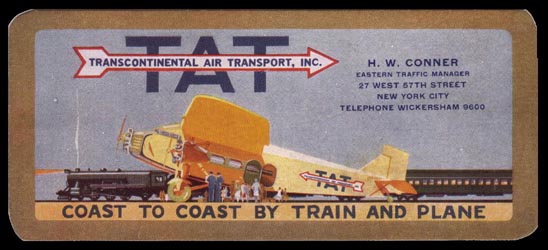
Charles Lindbergh that day flew the plane “City of Los Angeles” to Winslow, Arizona. From there, the next day on July 9, Charles Lindbergh flew the City of Philadelphia, back to Los Angeles. With the return flight, traveled Amelia Earhart and his wife Anne Morrow Lindbergh.
A curiosity: Upon arrival in Los Angeles (Glendale) there was a second christening of the Ford Trimotor 1929 City of Philadelphia. Again Gloria Swanson, movie star, christening for the second time the City of Philadelphia. Some 20,000 people attended the second christening of the plane that had just completed the first voyage of the transcontinental passenger airline.
During the first month of TAT ( Lindbergh Line) operations, 153 passengers traveled the entire route. Also 280 passengers made shorter trips between intermediate points. TAT reported that its passenger transport capacity index was 37 percent. 99.4 percent of scheduled miles were completed. The planes flew 113,240 of the planned 113,957 miles. The number of passengers and miles traveled increased during the following months.
Ford Tri-Motor 1929: Two Air Crash in Five Months
On September 3, 1929, a Ford Tri-Motor 1929 5-AT-21B NC 9647 “City of San Francisco”, westbound TAT flight crashed into Mt. Taylor in New Mexico. “All passengers and crew aboard died. The Associated Press said it was the first plane crash on a regular commercial land route. The September accident was the first of three serious accidents for TAT in the next five months. It was the first disaster of a commercial airline.
On January 19, 1930 TAT Flight Number 7, Ford Tri-Motor 5-AT-C crashed north of Oceanside, California. The plane encountered rain, low clouds, fog, and possibly engine problems, Flying from the races at Agua Caliente, near Tijuana, Mexico to Los Angeles.
The left wing struck the ground, slamming the aircraft into the ground, which subsequently caught fire. The pilots and all 14 passengers aboard died in the crash. Charles Lindbergh, as chairman of TAT technical committee, was involved in the investigation.
Ford Tri-Motor 1929 & Western Air Express
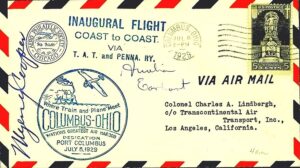
After the first accident many of the Transcontinental Air Transport passengers chose the train. TAT began offering more services on board, but they had no effect. The fall of the stock market in October 1929 plus the second accident, put Transcontinental Air Transport on the verge of Bankruptcy
The government offered airlines long-term mail contracts in exchange for buying larger and safer airplanes for passenger transport.Transcontinental Air Transport, which did not carry mail, merged with Western Air Express, which already had a contract with the government. The merger was announced on October 25, 1930. The company that later became TWA stopped operating its train service. From that moment on, the entire route began to fly with only one night stop in Kansas City..
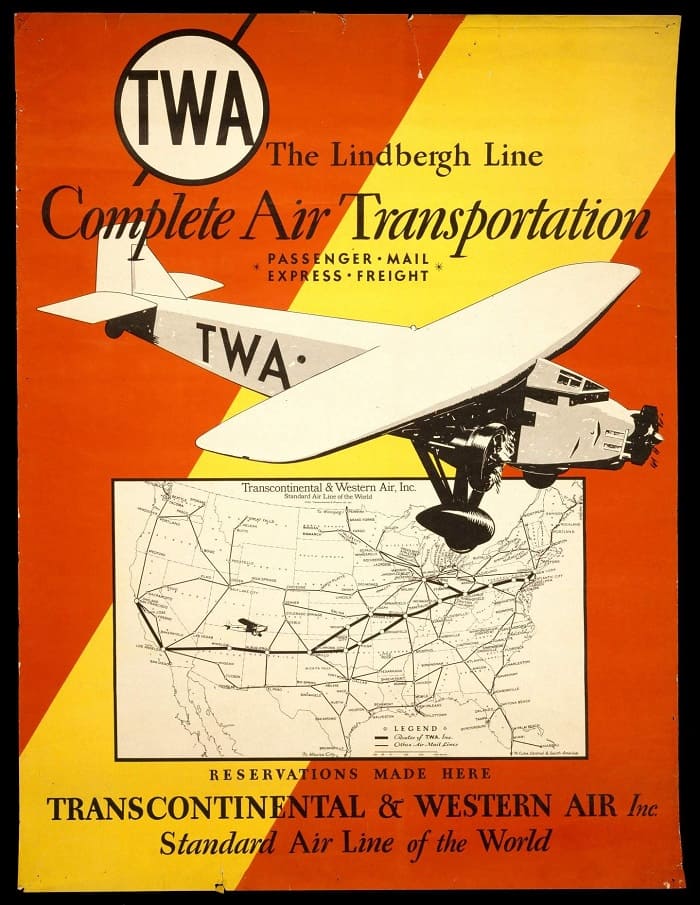
Are Ford Tri Motors still flying?
Two Ford Trimotors are still being used by the Experimental Aircraft Association (EAA) to fly passengers on sightseeing tours : a 4 -AT-E, bought by the association after a crash and fully restored Also a 5-AT-B owned by the Liberty Aviation Museum. At present there are almost 18 Ford Trimotor among those that are in operation, restoration and exhibition in museums. We will deal with this later in another note-
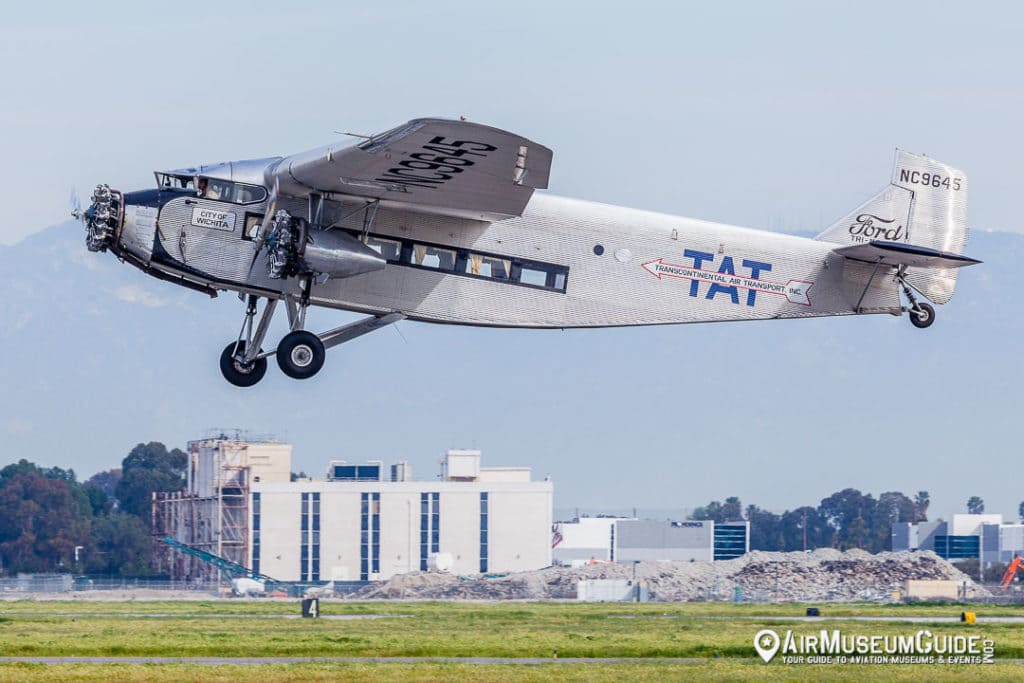
.
Tips of First Coast to Coast Flight: US History of Tourism – TAT
- The one-way fare from New York to Los Angeles was $ 352. It would be worth about $ 5,000 in 2019
- The trip lasted 48 hours – Train & Ford Trimotor
- The height of the flight was 8,000 feet.
- People made fun of the airline abbreviation (TAT) interpreting it as “Take A Train”
- The trip was a hard physical endurance test
- TAT was also called The Lindbergh Line
Sources First Coast to Coast Flight
- The Smithsonian Air & Space
- Flying In lingbergh Line – Robert F kirk
- The Building of an Airport : Port Columbus Robert F kirk
- Journal American Aviation Historical Society
- The Smithsonian Ford Plane
- Liberty aviation museum.org
- EAA Aviation Center – 3000 Poberezny Road – Oshkosh, WI 54902
- Palm Springs Air Museum
- Air Museum Guide
![Ford Tri-Motor - Flying the Lindbergh Line: Then & Now: (Transcontinental Air Transport'S Historic Aviation Vision) de [Kirk, Robert F.] Flying the Lindbergh Line: Then & Now: (Transcontinental Air Transport'S Historic Aviation Vision) de [Kirk, Robert F.]](https://images-na.ssl-images-amazon.com/images/I/51XTKvrD26L.jpg)
Related Post
- Best travel gadgets for hiking 2020
- Thomas Cook & Son History of Tourism
- The Grand Tour – Tourism in XVII Century
- Luggage – Suitcases – Backpack
- eReaders 2020
- American Forces Travel
- National Park Smoky
- Tourism in Roman Empire
- Amazon deals Products 2021
Tags: The Lindbergh Line – First Coast to Coast Flight – Transcontinental Air Transport – TAT – US History of Tourism – Ford Tri-Motor – Charles Lindbergh – Amelia Earhart – City of Los Angeles – City of Wichita – City of New York

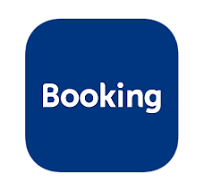

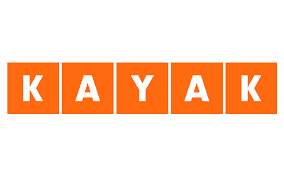




There are same pic in a this web
https://www.reddit.com/user/K1000ogrsna/comments/dsnty5/coast_to_coast_in_48_hs_1929_train_plane/?utm_source=share&utm_medium=web2x
WHAT COMPANY DID THE PRINTING AND ART WORK FOR FORD AVIATION??